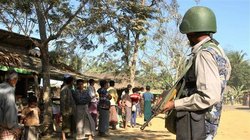 Rate of fatalities rises among refugees and asylum seekers who embark on sea journeys in Southeast Asia, according to a report.
Rate of fatalities rises among refugees and asylum seekers who embark on sea journeys in Southeast Asia, according to a report. RNA - Refugees from Southeast Asia, many of whom are members of Myanmar's Rohingya minority, continue to risk their lives to reach safety, according to a new report by the United Nations, which also highlights a much higher rate of deaths over the last year, according to Al-Jazeera.
The report released on Tuesday by the UN's refugee agency (UNHCR) said one person in every 69 refugees and asylum seekers who embarked on a sea journey last year in the region died or went missing at sea.
That is up from the one in every 81 ratio between 2013 to 2015, at the height of Southeast Asia's refugee and migrant boat crisis in the Andaman Sea.
"As long as the root causes of displacement are unresolved, refugees will continue to feel compelled to undertake dangerous journeys in search of safety for themselves and their families," UNHCR Director for Asian and the Pacific Indrika Ratwatte, said in a statement.
He appealed to countries in the region to provide "orderly and safe pathways" to reduce the danger for refugees and asylum seekers.
While the overall number of people attempting the journey has decreased, the fatality rate has increased, the report said, adding that between January and June of this year, 15 more people have died while attempting to cross seas and rivers.
"Confirmed reports are, however, only the tip of the iceberg given most bodies are never found and many missing persons never reported," the UNHCR announced.
In previous years, people smugglers were to blame for most of the deaths, due to beating, gunshot wounds or deprivation of food and water during the journey.
But since 2018, the primary cause of death or disappearance at sea was due to boats in distress, with many vessels without professional crews and not built for or equipped to make long journeys safe for refugees, the report added.
In Southeast Asia, the conflict in Myanmar remains the dominant factor pushing the forced migration.
Since August 2017, more than 740,000 members of Myanmar's long-persecuted mostly-Muslim minority fled to neighbouring Myanmar to escape a brutal military crackdown in Rakhine state.
In 2018 and this year, meanwhile, an escalating conflict between Arakan Army, an armed group seeking more autonomy for Rakhine state's Buddhist-majority population, and the Myanmar armed forces has displaced an additional 22,000 refugees - further complicating the situation on the ground and "exacerbating existing challenges and difficulties" faced by the Rohingya, the report added.
In a report in September, the UN Human Rights Council had warned that as many as 600,000 Rohingya remaining in Myanmar's Rakhine state face "a serious risk of genocide".
Refugees interviewed by the UNHCR this year recalled harrowing physical abuses by human traffickers, often to extort payments from relatives, according to the report.
One Rohingya boy told the agency that he escaped by himself to get away from the fighting in his area.
He said he was locked up along with other boys, and beaten with a rod by the people smuggler.
"He made me call my mother and turned on the speakerphone so she could hear me crying. He demanded the full payment from my mother. My parents had no choice but to sell their land to pay," he added
Four out of five refugees seeking safety in Bangladesh between January 2018 and June 2019 were women or children.
"Women and girls, especially those travelling on their own, reported incidents of sexual exploitation and gender-based violence," the report said.
In the case of maritime movements, an estimated 59 percent of individuals who moved irregularly by sea, or attempted to, were also women or children.
This represents a notable change from the period of 2013-2015 when the large majority of persons engaging in similar journeys were mostly men, the report added.
847/940